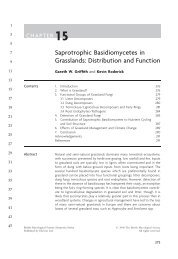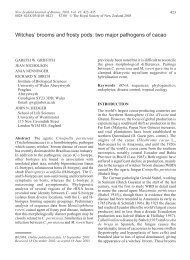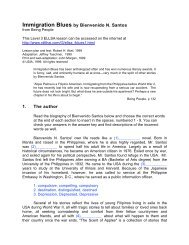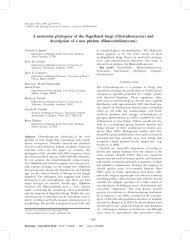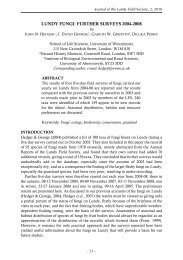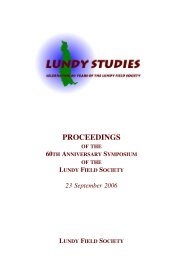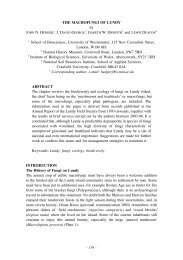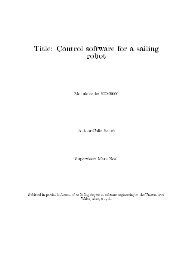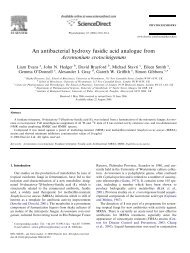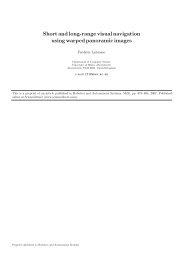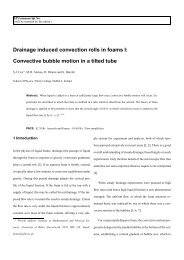Anaerobic rumen fungi
Anaerobic rumen fungi
Anaerobic rumen fungi
Create successful ePaper yourself
Turn your PDF publications into a flip-book with our unique Google optimized e-Paper software.
Agriculturally Important Microorganisms Vol. II<br />
and thus separating hemicelluloses and cellulose from lignin (Borneman and Akin, 1990) and<br />
render them accessible to hemicellulases and cellulases. Thus, through esterases, anaerobic <strong>fungi</strong><br />
play a more important role over bacteria in separating the lignin-polysaccharide linkages in the<br />
plant particles by extensive rhizoidal elongation, and are thus ahead of bacteria. N. patriciarum<br />
solubilized lignin (up to 34%) in sorghum (McSweeney et al. 1994). Unlike <strong>rumen</strong> cellulolytic<br />
bacteria, <strong>rumen</strong> <strong>fungi</strong> also have proteases that facilitate penetration of the plant proteinaceous<br />
components by fungal rhizoids (Engels and Brice, 1985).<br />
Most fibrolytic enzymes have been found associated with rhizomycelium while some<br />
secreted into the surroundings (Gordon and Phillips, 1992; Williams et al. 1994). The activities of<br />
these enzymes are common to both the zoosporic and vegetative stages as well as in the cell-free<br />
spent culture fluid (Williams and Orpin, 1987); but depend on the stage of the life cycle (Martin<br />
and Nisbet, 1992; Lee et al. 2001). A few fibrolytic enzymes are constitutive, and regulated by the<br />
presence of soluble sugars (Mountfort and Asher, 1983, 1985, 1989), e.g. production of cellulase<br />
repressed by glucose (Mountfort and Asher, 1985). Growth conditions greatly influence enzyme<br />
production as the level of fibrolytic enzymes was 3-fold in a stirred fermenter compared to static<br />
batch cultures (Morgavi et al. 1994; Paul et al. 2003).<br />
Because of the ability of cellulases to rapidly attack crystalline cellulose, there has been<br />
considerable interest in the fibre degrading enzymes of anaerobic <strong>fungi</strong> (Teunissen et al. 1993).<br />
Wilson and Wood (1992) reported that isolates of Neocallimastix and Piromyces were the most<br />
rapid degraders of crystalline cellulose. The weakening of tissues by fungal enzymes may<br />
accelerate digestion, and thus making rumination more effective in reducing particle size and<br />
increasing protozoal and bacterial digestion in the <strong>rumen</strong>.<br />
10. MICROECOLOGY IN THE RUMEN<br />
The interactions of anaerobic <strong>fungi</strong> with other <strong>rumen</strong> microbes can be positive, negative or<br />
neutral, depending on the microbial group involved and the type of substrate used. Since, <strong>rumen</strong><br />
<strong>fungi</strong> produce appreciable amounts of H 2; they can interact with H 2 utilizers which in turn alter<br />
their metabolite production. Methanogens are the principal H 2 utilizers in <strong>rumen</strong>; and stable<br />
cocultures of <strong>fungi</strong> and methanogens have been established in vitro (Fonty and Joblin, 1991; Orpin<br />
and Joblin, 1997). Such cocultures resulted in increased fungal biomass (Bernalier et al. 1989) and<br />
also an increase in the rate and extent of cellulose degradation (Wood et al. 1986; Joblin et al. 1989;<br />
Bernalier et al. 1991). Interspecies H 2 transfer between the cellulolytic H2-producing anaerobic<br />
<strong>fungi</strong> and methanogens resulted in increased CO 2 and acetate formation but decreased ethanol<br />
and lactate output (Bauchop and Mountfort, 1981; Mountfort et al. 1982). The presence of<br />
Methanobacterium arboriphilus, Methanobacterium bryantii, or Methanobrevibacter smithii also<br />
increased (5 to 10%) the level of cellulose fermentation by anaerobic <strong>fungi</strong> (Marvin-Sikkema et al.<br />
1990). By contrast, cellulose degradation and lactate production by N. frontalis decreased in<br />
cocultures with non-lactate utilizing Selenomonas ruminantium, the sugar fermenting, H 2<br />
consuming <strong>rumen</strong> bacterium, thus indicating interspecies hydrogen transfer (Richardson and<br />
Stewart, 1990).<br />
The <strong>fungi</strong> are involved in cross-feeding in that they release free sugars, which in addition to<br />
several of their normal metabolites (except acetate), serve as energy sources for other bacterial<br />
species. The <strong>fungi</strong> themselves may also depend on the bacteria for supply of B vitamins, heme and<br />
amino acids, as the nutritional requirement (Williams et al. 1994). On the other hand, coculture of<br />
anaerobic <strong>fungi</strong> with <strong>rumen</strong> bacteria inhibits the cellulolytic activity (Bernalier et al. 1992; Roger et<br />
382



